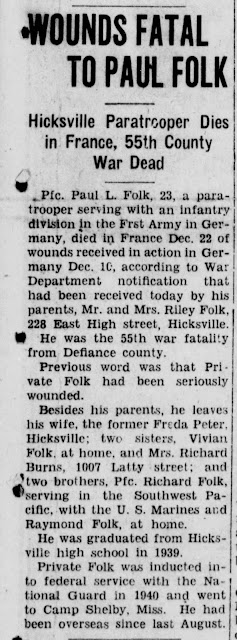Private First Class
Olen Ray Vincent
Born on June 28, 1920, in Hillsdale, Michigan, to Rev. Carl Austin and Amanda (Stover) Vincent, Olen moved frequently during his lifetime. His father, a pastor of the United Brethren Church, had many different parishes during his career, including at Sherwood and Hicksville, Ohio in the 1940s.
Olen graduated from Monclova High School and then went on to Huntington College, graduating in 1942, with majors in music and mathematics. He earned his teaching license and began to prepare for a career in education.
Before he could step into a classroom, though, duty called.
His parents had a Sherwood address when he registered for the draft in July 1941, but Olen was residing in Huntington, going to school and working at Crites Bakery. After graduation, he enlisted in Toledo on July 25, 1942, joining the Army. After training around the United States, he left for overseas in late July or August 1944.
Private Vincent was part of the 379th Infantry Regiment, 95th Division of General Patton's 3rd Army. In France, he arrived in time to take part in the Battle of Metz, a heavily fortified city in France, in December 1944. It was here that he earned a Silver Star which was awarded posthumously.
The Republican, a newspaper from Wauseon, Ohio, reported the award on July 12, 1945:
"Rev and Mrs. Carl A. Vincent, Delta, received the Silver Star, July 6th, posthumously awarded their son, PFC Olen R. Vincent. The citation reads in part:
'For gallantry in action against the enemy on 10 December 1944, when his comrades were pinned to the ground by fierce machine gun from an enemy bunker, Private First Class Vincent leaped into a shell hole and opened fire with his automatic rifle, forcing the enemy to shut the apertures.
Before the Germans could close the door, PFC Vincent rushed the fortification, hurling grenades which wounded four of the frantic garrison. By the time his comrades reached the bunker, PFC Vincent had elicited the surrender of ten Germans. His bold and gallant actions reflect lasting honor on him and on the military service."
The infantry who fought in Metz were given the nickname, "The Ironmen of Metz."
In an unknown newspaper, this obituary and memorial appeared:
"Olen Ray Vincent only son of Rev. and Mrs. Carl Vincent, Delta, was born in Hillsdale, Michigan, Hillsdale County, June 28, 1920, and was reported by the War Department killed in action in Germany, March 4, 1945. age 24 years, 8 months, and 4 days.
When nine months old, he moved with his parents to the James I. Post farm near Hillsdale, Michigan. It was while living there, Mr. and Mrs. Post learned to love Olen and cared for him as they would a child of their own.
When he was four years old, he moved with his parents to a farm near Frontier, Michigan and lived there ten years, where he also attended a country school known as the East Maple Grove and there completed his grade school work.
The conference stationed Rev. Vincent at Hicksville, Ohio and they remained there one year and then were sent to Monclova, Ohio, where Olen graduated from high school. He then decided he wanted to enter college, willing to work his way through as much as possible. It was through the kindness and financial help of Mr. and Mrs. Post that he was able to graduate from Huntington College, Huntington, Indiana, in June 1942. He had his teachers' license and was ready for teaching school, but was inducted into the army and left for camp on his father's birthday August 8, 1942.
He trained at Camp Swift, Texas, Fort Sam Houston, Texas, Camp Polk, Louisiana, and Los Angeles, California and left for overseas the last of July or forepart of August 1944, from Indiantown Gap, Pa."
Another newspaper article, source unknown, wrote this about PFC Vincent:
"He was a very quiet disposition, never complaining of his lot. He was converted at the age of 13 at the West Woodbridge U.B. Church ...and at the time of his death was a member of the Traill Chapel U.B. Church in Delta, Ohio.
He was known to have received medals, among them the expert rifleman's badge, rating second in his company, the Good Conduct ribbon, combat infantryman's badge. and his name had been turned in for the silver star a short time before his death.
He leaves to mourn, his parents..., sister Leona, fiancée Miss Marjorie Brokaw of Muncie, Indiana; grandparents, Mr. and Mrs. Homer Stover, Montpelier, O.; friends, Mr. and Mrs. James I Post, Hillsdale; uncles, aunts and a host of other relatives and friends..."
The same day he died, another local man from Defiance, Arthur E. Ury, also made the ultimate sacrifice, marking a solemn moment for their shared community.
PFC Olen Ray Vincent was laid to rest at the Netherlands American Cemetery and Memorial, Margraten, Holland. PFC Vincent also received the Purple Heart posthumously.
Kim Bercaw, Researcher







.jpeg)


























.jpg)






